Earth as lover, earth as self

This piece's title was inspired by Joanne Macey's book of the same name;
Earth as Lover, earth as self.We can be concerned for the environment because of a moral position, or an intellectual position. Or we can be concerned because the earth is intimately connected to our sense of self... an extension of ourselves ... or even a fundamental part of our being. Thus to hurt the earth is to hurt ourselves. To see parched earth and dying roots is to feel physical pain.
So with this in mind, what sort of piece might capture that sense of self as organically and spiritually intertwined with the earth? Is it a co-incidence that made from clay it is connecting at a fundamental level to earth itself anyway? It has to be globular, organic... a human figure transmuting into earth, into root. Or is it even Gaia... mother figure?
Technical Notes
Whenever I make a piece whose form is rotund like this I often find it easier to work in solid clay, rather than handbuilding with coils. So firstly I put one block of clay on the pottery wheel (which I use as a turntable) and then add bits to give a curve. Using my fingers I take away the excess.... yes those are finger marks you see in the clay. I turn it over and take away more clay on the bottom to get a rounded, earth globe feel to it.

Now I turn it right way up and add the torso and arms using handfuls of clay.
Next I make a pinch pot which becomes the face and I add clay to it till I get the full head (still with a hole in the back.) I check that the size is right. I work the features into this hollow round shell, using my thumbs to create the eye sockets and then needing to add more clay because the eyes are closed and therefore need to be slightly bulbous. Ooops.
Now I am ready to stick the head onto the neck. I play with the angle until I get the right feeling that a certain tilt to the chin gives. And now I can refine the lips to get an expression of serenity and connection. Even just doing this I find my breathing slowing and a sense of connection coming over me. A sense of being fully present.

The head is staying on OK, so I don't need to put a skewer through the top of her head down into the neck as is usual. Must be because of that thick neck.
Now I wait for a week before I hollow her out and add the headdress. I use a bag and a half of clay and recover about 3/4 a bag after hollowing out. I add a little water to all my bits of recovered clay and allow to soften in the bag. I will wedge that up next week after it has softened enough not to require surgical enhancements.
It is interesting how static the body looks without the head, and then as soon as the head is put on, with just a slight tilt, the whole piece is given some life and movement. Sometimes it only takes a slight movement or tilt in a chin or a shoulder and a piece is transformed. The trick is not being impatient in the earlier stages to put too much movement in. But even so, I couldn't help but make the legs and knees slightly assymetrical... one higher than the other, one more in front.
What's in a title?
I am in the process of brainstorming the title for my next exhibition.
I thought I had it...
Beware the surface dwellers... but it is a bit negative...
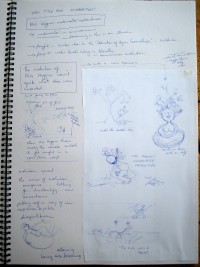
so I came up with
Mrs Higgins underwater adventure... which is still on the theme of going deep... deep into consciousness (water is a great metaphor for that) and deep into otherness, earth and the cosmos. As a result of that title I came up with lots of ideas for some pieces.... lighter, more fanciful... as one might expect from such a title.
But perhaps, after all, this title is just another stepping stone. I have been doing a lot of reflecting lately. This blog writing helps me to step back from the
doing into big picture questions... like what really are my intentions in putting together an exhibition... what is the sort of art I am interested in doing...
... perhaps one which transforms, inspires, elevates, perturbs?

I am remembering my previous exhibition of 10 months ago which went through a few name changes.
The final title was
The Seduction of Agnes Scornethope which came to me after experiencing for myself the nature of seduction (and I don't mean in the physical sense). During this experience I was in a state of disequilibrium, anticipation, intrigue, excitement, playfulness. "Hmmm." I thought, "could I create a whole exhibition which might create this sense of
being seduced in my viewers?" Pieces could use paradox, out of place parts, depth, layers etc... to entice people into a journey of delightful discovery. Well it seemed that it worked from the comments I received. And there was also a lot more which emerged.
So I am asking myself, for my next exhibition, what
state of being would I like to create in my audience? Perhaps I have been focussing too much on asking how I could perturb my audience to
see in new ways. There is a relationship between
being and
seeing. If we are in a certain state of
being we might see things we might not ordinarily see. When we are invited to
see in new ways it helps us move into a new state of being. A flux, flow, evolution perhaps. But really can I control or engineer a state of being in anyone? Perhaps all I can hope for is to hold a state of being in myself and allow that to flow into my work, without letting my brain get too much in the way.
What state of being am I in now? Well I would have to say it is a state of disequilibrium. I am going through big questions in my life about direction, letting go the old and allowing space to enable creation of the new... new opportunities as well as a new self. Yes, I am experiencing the disequilibrium of evolution.... could this be the theme of my next exhibition?
The disequilibrium of Mrs Higgins?The evolution of Mrs Higgins is not going quite to plan...Each new idea seems to paint images in my head of posssible pieces and I am quickly recording them in my visual diary. Who knows what the title might evolve to next, but the journey is interesting!
Where is the smell?

I woke up this morning after a decent rain. There is something magical about the smell when it has been dry for a while. Eucalypt, freshness... and then all that this evokes... new possibilities... past memories of similar days.
Smell is such a powerful sense but so easily ignored. What might smell sculptures be like?
I have found some interesting sites which show the latest in sculptures...
Kinetic sculpture - a robot arm which follows a satellite as it orbits around the earth.
Water sculpture maze which changes as people try to walk through it.
A sound sculpture in a street which people can tune into using their iPods.
Clay really in comparison is so boring. The end result is so static. Yet the process of bringing it to life is not. Feel a piece of clay and you are rubbing together
Earth and
Water. Fire it and you bring in
Fire and
Air. Paint it and you bring in
Metal. Voila! The five elements. Hmmm. But where is the smell?
My favorite water sculpture.... Denison Beach near Bicheno on a northeasterly... the waves are huge and changing, masterly and powerful. The white noise is filled with rhythm that pulses with the body's soul beat. The spray cuts through your skin into your very essence. The smell is one of new beginnings. As you walk along the beach you feel the sand sink below your feet ... the earth subsiding and embracing you. The incoming waves dance in a way that requires your attention as you move in and out of them. The various layers of water lines on the beach remind you that you are on a planet with a powerful satellite and the more you come to this place the more you feel the rhythm of the tides.... the pull of the moon.
I haven't got a photo. You have to be there.
What goes on the bottom?
Technical NotesSo you have just spent $1100 on a sculpture weighing about 10kg. The last thing you want is to scratch your $2000 huon pine sidetable.
I put felt on the bottom of my pieces which I buy either in squares for the smaller ones, or by the metre for the larger ones. This protects the surfaces the sculptures are on as well as helping greater stability of the piece. Here I am putting felt on my piece
Shit Happens.
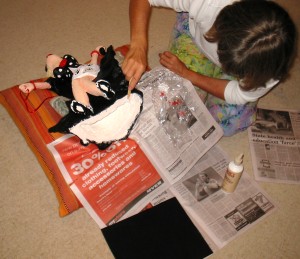
1. Turn over the piece, placing it in a supportive environment (nice music and a psychiatrist on hand).
2. See with shock all the spots you didn't reach when previously painting. Paint.
3. Then apply PVA craft glue to the bottom and avoid dripping over your expensive cushions from Freedom Furniture.
4. Line up felt to cover all bits and stick down... good idea to test if it fits before you start.
5. Turn back over onto a flat surface and wait to settle in position and the glue to dry.
6. Cut out to the shape. (I use very sharp small scissors (which were quite expensive and therefore I treat them with care... no cutting with wet glue!)
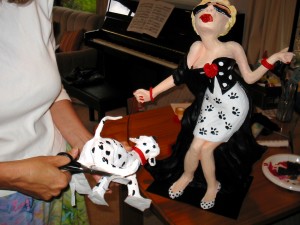
rather than a Stanley knife or scalpel as it doesn't cause fraying and tearing.)
7. Now place on top of the piano without fear of ruining the polish.
If you wanted to know what is inside my sculptures look closely at the piece lying down. This one is coil built up to the hips which requires a lot of pre-thinking about the intended shape and support structures. Because I wanted the legs showing, I needed a full length cape to support the piece.
reclining "nakedness" in clay
Recipe: Take one Lhote painting (see previous post) and somehow turn it into a 3 dimensional object. Ooops, I better not use the word object in the same context as a reclining nude. No, this is a fully actualised woman, revealed to herself.
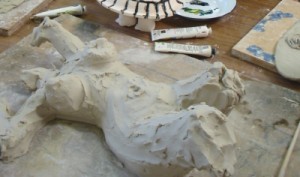
It takes 3 bags of clay. I decide to build solid and hollow out later. I quickly put blocks of clay together from the bags to make the torso using my fingers to drag excess away. I get a shape. Then quickly I stuff balls of clay together to build out the legs. I am still not sure where they are going and working with solid clay means I can change my mind as I go. Building a hollow form requires a lot more forethought. She is big and will just fit into the coffin kiln - about 80 cm long.... but I am not even thinking of those practicalities as I am in the flow of creation.
I let her dry for a few days and come back ready to adjust the shape. I decide even though she is still quite malleable to hollow her out using pin hole surgery... taking a strip of clay along the leg and then removing. Once hollowed, I add back the missing strip. I put in the deep caverns of calf lines as shown in the Lhote picture. I get down on the floor and get into the pose, feeling where my stomach muscles pull. Now my back is full of clay dust!
I also turn her gently and hollow from the back trying not to squash the detail. Hmmm, no such luck, but easily fixed. Now I let her dry again for another week. I am back smoothing, putting in the toe details, realising that the foot resting on the floor is not quite right - building up the heel and that wonderful curve. As I do so I realise how beautiful feet are when in stretched poses. I love the ways the toes hug the knees, crimping over. I emphasise with a turning tool the lines and the form. I start dreaming about feet and their possibilities. (more on that later)
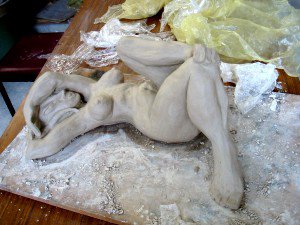
Another week under loose plastic and voila! Here she is! Now I need to wait a few weeks until I can fire her.... then she will be painted with those wonderful voluptuous colours... then a poem... and maybe she will be ready for the
Material Girl Exhibition in March. Do you think this is a woman for all seasons?
Oh yeah, after hollowing out, I have recovered about 1.5 bags of clay which I pummelt together and wedge up ready to be made into coils for my next piece.
Is nude rude?
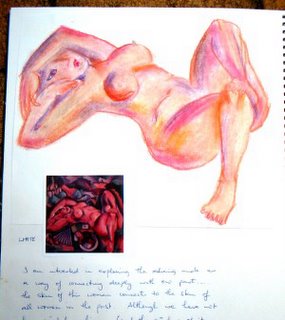
Just before Christmas I treated myself to a beautiful book
Reclining Nude by
Lidia Guibert Ferrara which has large colour pics of reclining nudes from 1844 to 2002.
I particularly loved the painting
Bacchante by
Andre Lhote and while on holiday decided to explore skin textures by creating a pastel copy of it. I have realised that there is nothing like copying another work to begin to get inside it. it is not something I normally do. I began to realise how different this reclining nude was to many of the others. She wasn't so much posed for an artist in an attractive position, but seemed to be natural and for herself. It brought back memories of my research into the nude in art and feminist art back in 2002 and the objectification of women.
John Berger from
Ways of Seeing says:
To be naked is to be oneself. To be nude is to be seen naked by others and yet not recognized for oneself. A naked body has to be seen as an object in order to become a nude.
Nakedness reveals itself. Nudity is on display.
I felt that in this painting the woman was revealing herself rather than on display, unlike many of the other nudes in the book.
I then got into the pose... and please try it... not an easy one to relax in... you should feel extension through the waist and disequilibrium around the hips. There is something wonderful about the earthiness of the toes bent around the knee. As I lay in this pose I felt connected with this woman in the picture. Am I also a work of art? In this pose I am myself, yet connected through history with so many women also who have inadvertently taken this position. Does this pose reveal me as it reveals to me what being a woman is?
Does this mean for every physical position we take there is a greater memory connecting us to our species, or even other species? Hmmm. Are pictures of women in art immortalising for us this physical reality of being. Do we need them to see ourselves?
Anyway, I could feel a sculpture coming along....
 This piece's title was inspired by Joanne Macey's book of the same name; Earth as Lover, earth as self.
This piece's title was inspired by Joanne Macey's book of the same name; Earth as Lover, earth as self. Whenever I make a piece whose form is rotund like this I often find it easier to work in solid clay, rather than handbuilding with coils. So firstly I put one block of clay on the pottery wheel (which I use as a turntable) and then add bits to give a curve. Using my fingers I take away the excess.... yes those are finger marks you see in the clay. I turn it over and take away more clay on the bottom to get a rounded, earth globe feel to it.
Whenever I make a piece whose form is rotund like this I often find it easier to work in solid clay, rather than handbuilding with coils. So firstly I put one block of clay on the pottery wheel (which I use as a turntable) and then add bits to give a curve. Using my fingers I take away the excess.... yes those are finger marks you see in the clay. I turn it over and take away more clay on the bottom to get a rounded, earth globe feel to it. Now I turn it right way up and add the torso and arms using handfuls of clay.
Now I turn it right way up and add the torso and arms using handfuls of clay.









